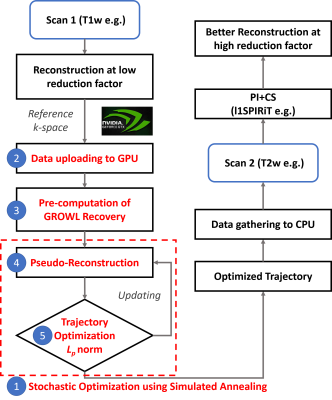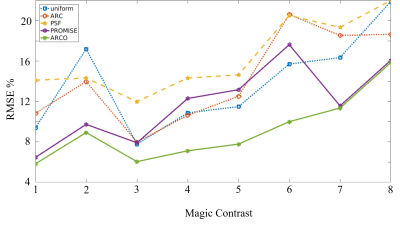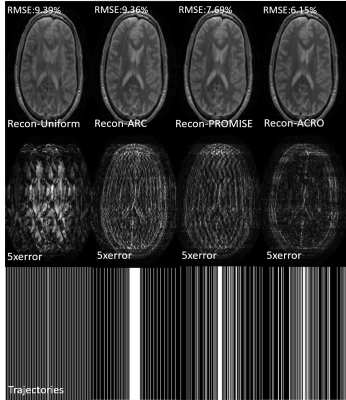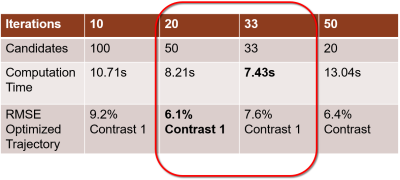2886
Real-time Personalized Acquisition Optimization: 30%-50% reconstruction improvements from a 10-second undersampling optimization1Department of Biomedical Engineering, Tsinghua University, Beijing, China, 2Department of Electrical Engineering, Stanford University, Stanford, CA, United States, 3GE Healthcare, Menlo Park, CA, United States, 4Department of Radiology, Stanford University, Stanford, CA, United States
Synopsis
Improved undersampling designs can effectively improve the acquisition and resulting reconstruction accuracy. However, existing undersampling optimization methods are time-consuming and the limited performance prevent their clinical applications. Here we proposed an improved undersampling trajectory optimization scheme to generate an optimized trajectory within seconds and apply for subsequent multi-contrast MRI datasets on a per-subject basis. By using a data-driven method combined with improved algorithm design, GPU acceleration and more efficient computation, the proposed method can optimize a trajectory within 5-10 seconds and achieve 30% - 50% reconstruction improvement with the same acquisition cost, which makes real-time under-sampling optimization possible for clinical applications.
Purpose
MRI suffers long acquisition time resulting in more motion artifacts and limiting clinical applications. To overcome these limits, methods combining parallel imaging (PI) and compressed sensing (CS) [1,2] enable scan acceleration through undersampling k-space. Various trajectory optimization methods [3,4] have been proposed to further improve acquisition with optimized trajectories, which significantly improves resulting reconstruction accuracy compared with a fixed undersampling trajectory at the same acceleration factor. However, the high computational costs and limited performance of existing methods prevent their clinical applications. The goal of this work is to develop a method to generate an optimized trajectory within seconds and apply to multi-contrast MRI datasets as validation.
By using a data-driven trajectory optimization method combined with improved algorithm design and GPU acceleration, the proposed method can optimize a trajectory within 5sec-10sec and achieve 30%-50% reconstruction improvements.
Method
- Trajectory optimization framework
The study is based on a previously proposed data driven method [5], which optimizes trajectories for subsequent multi-contrast series based on information from a previous (T1w) scan, as shown in Fig. 1. By using improved cost function and stochastic optimization, this method can optimize a 1D-undersampling trajectory within a minute, which is already much more efficient than other methods yet still needs further acceleration for feasible clinical purposes.
- Hardware Acceleration
To further improve the performance and efficiency of the method, both hardware acceleration and software/algorithm level designs were used. By optimizing the implementation, the method can be highly parallelized and accelerated using a GPU (GTX 1080Ti).
- Algorithm designs
To improve the performance of trajectory optimization, the stochastic optimization method used in trajectory optimized was improved by using ARC variable density undersampling [6] as an initialization. Besides, we also further explored the algorithm hyper-parameter. For a fixed number of 1000 candidate trajectories to evaluate, we tried multiple choices of parameter sets, including iteration number and the number of candidate trajectories updated in each iteration: (10×100), (20×50), (33×33), (50×20).
Dataset and Experiments
To evaluate the performance and efficiency of the proposed method, we conducted experiments to optimize trajectory using previous T1w brain images and applied the optimized trajectory to a multi-dynamic multi-echo acquisition (2D FSE with 4 saturation delays and 2 echoes), acquired on 3T (GE MR 750 Waukesha, WI) using 12 channels of a head array. For comparison, we compared the resulting errors using PI+CS reconstruction method (L1-ESPIRiT, BART toolbox) with different 1D-undersampling trajectories, using 1) uniform undersampling, 2) variable density undersampling (ARC), 3) Point-Spread-Function (PSF) optimized pseudo-random trajectory [1] and 4) the proposed method (named PROMISE, ARCO). All our algorithms were implemented with MATLAB 2016b.Results
Fig. 2 shows the comparison of the reconstructed 8 contrast images of the multi-echo multi-contrast datasets using different trajectories: uniform undersampling, variable density undersampling (ARC), PSF optimized undersampling and the proposed method (PROMISE/ARCO). For the proposed method, the parameter set (20×50), which makes the algorithm to use 20 iterations with 50 candidates updated per iteration, was selected. The detailed reconstruction results and errors are shown in Fig. 3, in which the proposed method demonstrates superiority with reduced aliasing artifacts and errors. The optimized trajectory using the proposed method results in more than 30% RMSE reduction compared with other trajectories under the same acquisition cost.
Fig. 4 shows the comparison of time costs for trajectory optimization and resulting reconstruction errors. To optimize a 1D random undersampling trajectory with the proposed method, it only takes 7.43 seconds on a GPU with improved algorithm. The tradeoff between candidate size and iteration number is shown in Fig. 4.
Discussion
The proposed method, with redesigns and acceleration, can be over 10× faster than the original data-driven method and over 100× faster than more sophisticated trajectory optimization methods. Fig. 3 also validates the method and shows that our method could result in about 30%- 50% RMSE improvements which can help to further push acceleration for acceptable image quality.
On average, the method only takes 5sec~10sec to optimize an undersampling design for PI+CS, which is efficient to integrate into current imaging workflow for personalized and improved acquisition protocol.
Conclusion
Here we present a GPU accelerated efficient scheme for clinically applicable trajectory optimization. The result, validated on in-vivo multi-echo MRI dataset, shows that it achieves 30%-50% reconstruction error reduction while only takes 5sec~10sec to optimize trajectories on a per-subject basis.Acknowledgements
No acknowledgement found.References
- Lustig, et. al. MRM 2010
- Uecker, et. al. MRM 2013
- Seeger, et. al. MRM 2010
- Liu, et. al. IEEE EMBC 2012
- Enhao et al. p.2376 Proceedings of the ISMRM, 2013
- Beatty et al. p.1749. Proceedings of the ISMRM, 2007
Figures



